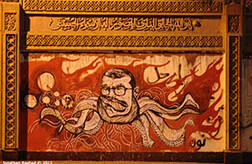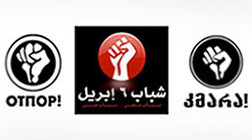This op-ed was originally published in Foreign Policy on April 5, 2013, and is posted here with kind permission.
Fifteen years ago, when Serbia's non-violent pro-democracy movement, Otpor, was just a tiny group of 20 students with $50, we decided to play a prank. We took an oil barrel, taped a picture of Serbian dictator Slobodan Milosevic to it, and set it up in the middle of Belgrade's largest shopping district. Next to it we placed a baseball bat. Then we went for coffee, sat down, and watched the fun unfold. Before long, dozens of shoppers lined the street, each waiting for a chance to take a swing at "Milosevic"—the man so many despised, but whom most were too afraid to criticize. About 30 minutes in, the police arrived. That's when we held our breath, waiting for what would happen next. What would the Milosevic's police do? They couldn't arrest shoppers—on what grounds? And they couldn't arrest the culprits—since we were nowhere to be seen. So what did Milosevic's police do? The only thing they could: They arrested the barrel. The image of the two policemen dragging the barrel to their police car was the best photo shoot in Serbia for months. Milosevic and his cronies became the laughing stock of the nation, and Otpor became a household name.
Revolutions are serious business. Just recall the grumpy faces of 20th-century revolutionaries like Lenin, Mao, Fidel, and Che. They could barely crack a smile. But fast-forward to the protests of the 21st century, and you see a new form of activism at work. The ominous scowls of revolutions past are replaced by humor and satire. Today's non-violent activists are inciting a global shift in protest tactics away from anger, resentment, and rage towards a new, more incisive form of activism rooted in fun: "Laughtivism."
Just take the Middle East and North Africa, where non-violent protesters are using laughter and wit to embolden their calls for democracy. In Tunisia, in January 2011, at the height of the protests against Ben Ali, a lone man—later immortalized as a super-hero Captain Khobza (bread)—fought off Ben Ali loyalists armed with a sharp wit and a French baguette. In Egypt, an outlandish video portraying Egyptian President Mohammed Morsy as Super Mario made the rounds on YouTube this March. In Sudan, students have taunted Sudanese Dictator Omar al-Bashir, holding "elbow-licking" protests—a reference to the derogatory term he used to denigrate the democratic opposition. Even in Syria—where the civil war has taken 70,000 lives—satirical anti-Assad graffiti and biting slogans have electrified street protests.
And in case anyone needed reminding, the political relevance of comedians in the Middle East was recently brought home by the Egyptian government's decision to raise criminal charges against the talk-show host Bassem Youssef (the man often described as "Egypt's Jon Stewart"). The move by the government of Mohamed Morsy attested to the capacity of humor to discomfit the powers that be. (For the moment, Youssef remains free on bail.)
But the strategic use of humor isn't confined to the Middle East and North Africa alone. In the United States, Occupy Wall Street protesters regularly used humor to mock corporate America. Who can forget the ridiculous-looking protestors who, dressed as rodeo clowns and a matador, tamed Wall Street's legendary bull statue? Even in Spain, where protestors are branded Indignados ("the Indignant"), laughter is a potent weapon. Satirical theatrical performances, flash mobs, and seemingly spontaneous outbursts of singing and dancing, have become hallmarks of Spain's anti-capitalist movement, helping to reduce tensions and sustain enthusiasm for two years and counting. Russians, too, have infused laughter into their demonstrations—using everything from condoms, boa constrictors, mental hospitals, and even Lego toys to poke fun at Putin.
There is a reason why humor is infusing the arsenal of the 21st-century protestor: It works. For one, humor breaks fear and builds confidence. It also adds a necessary cool factor, which helps movements attract new members. Finally, humor can incite clumsy reactions from a movement's opponents. The best acts of laughtivism force their targets into lose-lose scenarios, undermining the credibility of a regime no matter how they respond. These acts move beyond mere pranks; they help corrode the very mortar that keeps most dictators in place: Fear.
Take Egypt again. For decades, Mubarak's Egypt was a country in which political opposition was stifled at the hand of state-sanctioned abuse, arrest, and murder. Mubarak lived on that fear, and he had every reason to expect that he could use it to squash the protests that emerged on the heels of the Tunisian revolution of early 2011. Which is why he denounced protesters for serving "foreign agendas." But rather than take the regime's bait, activists successfully used Mubarak's culture of fear against him. In the early days of the anti-Mubarak protests, activists took to Tahrir Square carrying ordinary notebooks and an ingenious complaint: They'd left their foreign agendas at home. Their defiance soon spread beyond Tahrir Square, often spurred by new media. One computer message depicted an "Installing Freedom" screen grab, showing files being copy-and-pasted from a folder labeled "Tunisia." The photo was accompanied by an error message reading "Cannot install Freedom: Please remove ‘Mubarak' and try again."
Humor quickly became a central part of the anti-Mubarak communication strategy, serving two primary purposes. On the one hand, witty puns, biting caricatures, and snarky performances made it "cool" to come to Tahrir square and to be seen as politically active. Every day, larger crowds and new faces joined the square's protests—not only because they wanted to oust Mubarak, but also because they wanted to be a part of the "comic explosion" unfolding across the nation.
Today's protestors understand that humor offers a low-cost point of entry for ordinary citizens who don't consider themselves particularly political, but are sick and tired of dictatorship. Make a protest fun, and people don't want to miss out on the action.
On the other hand, acts of humor and cunning reminded the outside world that Egypt's protestors weren't the "angry young men" and fervent radicals that the regime would have them believe. Humor effectively communicated a positive image of the Egyptian uprising and won the sympathy of the international community.
It's a message that the youth of the Arab Spring haven't forgotten. Kids' embrace of the Harlem Shake in Egypt and Tunisia recently turned the Internet meme into a funky satirical protest that underlined the creative, democratic aspirations of so many young people across the region. Once again, the international community has been forced to recognize that the region's youth are not just the football hooligans we see on TV—they're young kids eager to embrace democracy. They just want to be able to have fun doing it.
And so do millions of other people around the world. By using humor, activists confront autocrats with a dilemma: the government can either crack down on those who ridicule it (making itself look even more ridiculous in the process) or ignore the acts of satire aimed against it (and risk opening the flood gates of dissent). Indeed, when faced with an act of brazen mockery, oppressive regimes have no good choices. Whatever they do, they lose.
But perhaps the best example comes from Putin's Russia. There, a Siberian anti-Putin toy protest featured teddy bears, Lego characters, and South Park figurines. It was toys only—no humans allowed. So what happened? Did Russian authorities find the culprits? Did they arrest the toys? You bet they did. After confiscating the Lego figurines, Siberian authorities imposed an official ban on all future toy protests. On what grounds? That the toys were made in China.
In the months that followed, the antics of Siberia's troubled officials went viral. In the process, they've reminded dictators the world over that once the spirit of laughter and people power comes out of the bottle, there's no stopping it.
Political humor is as old as politics itself. Satire and jokes have been used for centuries to speak truth to power. They infused protests against the Soviet Union in the 1980s, the peace protests of the 1960s, and inspired resistance movements in Nazi-occupied territories during the 1940s. But today's non-violent activists have taken humor to another level. Laughter and fun are no longer marginal to a movement's strategy; they now serve as a central part of the activist arsenal, imbuing the opposition with an aura of cool, helping to break the culture of fear instilled by the regime, and provoking the regime into reactions that undercut its legitimacy.
Of course, just because laughter in non-violent struggle is now common, it does not mean that it is easy. To the contrary, laughtivism requires a constant stream of creativity to stay in the news, headlines, and tweets, as well as to maintain a movement's momentum. Without creativity and wit, laughtivism can wilt before a movement's ambitions are met. And without discipline and sound judgment, mockery can quickly descend into chaos and violence.
But when it works, it really works. In the case of the arrested barrel in Serbia; what may have seemed like isolated acts of humor soon proved infectious, inspiring activists across the country. Before long, Otpor had transformed itself from a small student group into a national movement of 70,000 members. Once the barrier of fear had been broken, Milosevic could not stop it.



